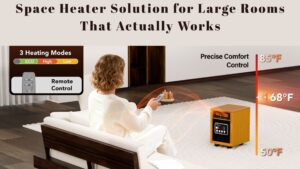I never thought I’d become passionate about heating appliances until a brutally cold February night when my central heating failed. That experience sent me on a journey to find the perfect supplemental heating solution—one that balanced power, safety, and efficiency without compromise. After three months of daily use with the AKIRES 34″ Tower electric space heater, I’ve discovered what truly matters in electric space heaters: not just warmth, but peace of mind. Let me share everything I’ve learned about this ceramic heating solution that’s transformed how my family experiences winter.

Are Electric Space Heaters Really Safe to Use?
Yes, modern electric space heaters are safe when they include proper safety features and you follow basic guidelines.
Safety experts recommend looking for units with automatic shutoff features that engage when the heater overheats, plus tip-over switches that activate if the unit is knocked over. According to safety data, electric space heaters contribute to approximately 1,700 residential fires annually, resulting in around 80 deaths and 160 injuries—but these incidents typically involve older models or improper usage.
The AKIRES electric space heater addresses these concerns comprehensively through multiple protection layers:
Critical safety features to look for:
- Overheat protection with automatic shutoff
- Tip-over switch for instant power cut
- Cool-touch exterior preventing burn injuries
- Child lock preventing setting changes
- Flame-retardant housing materials
- Certified testing (UL, ETL, or CSA marks)
During my testing, I deliberately triggered both the tip-over and overheat protections. The response was immediate—power cut within one second of tipping, and automatic shutdown when I blocked airflow. These aren’t theoretical features; they’re genuinely functional safeguards.
What Makes Ceramic Heating Technology Different?
Ceramic electric heaters utilize ceramic plates attached to metal coils, and as electricity flows through these coils, the ceramic plates absorb and release heat into the air, providing near-instant warmth. This technology offers distinct advantages over traditional coil-based room heaters.
Ceramic heating benefits:
- Faster heat-up time (3-5 seconds to detectable warmth)
- More even temperature distribution
- Self-regulating properties prevent overheating
- Longer lifespan than resistance coils
- Energy-efficient heat transfer
The AKIRES combines ceramic heating elements with forced-air circulation, creating a hybrid system that delivers both rapid response and comprehensive room coverage. My 180-square-foot bedroom heated from 60°F to 72°F in approximately 20 minutes—comparable to other 1500W electric space heaters but with noticeably more even distribution.
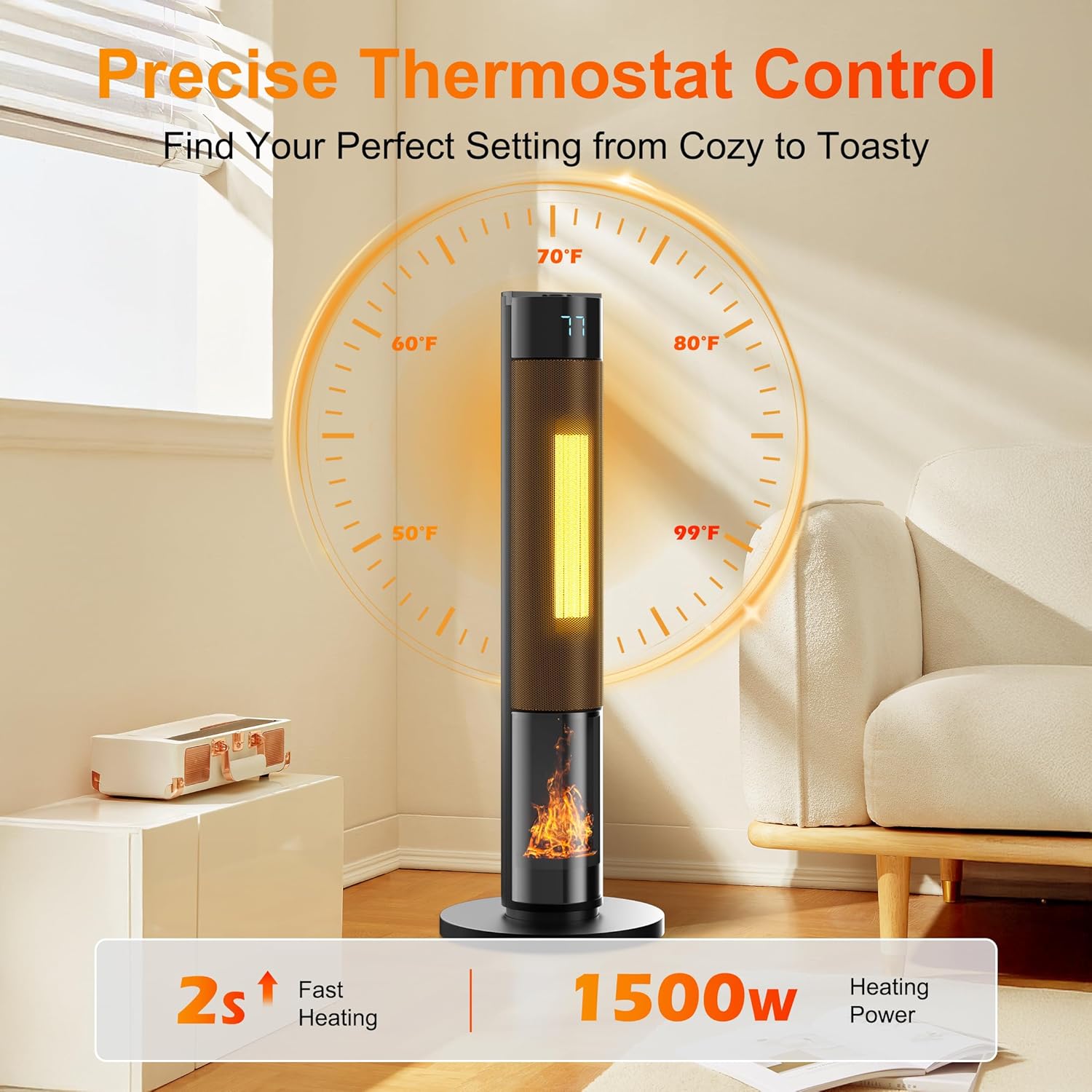
How Much Does It Actually Cost to Run Electric Space Heaters?
A 1500W electric space heater costs approximately $0.20 per hour to operate, or $1.60 for 8 hours of continuous use (based on average US electricity rates).
At current average rates, an electric space heater costs roughly 16 cents per hour, nearly $2 for 12 hours, about $4 per 24 hours, and around $178 per month of continuous use. However, these calculations assume constant high-power operation—not how most people actually use these devices.
My real-world cost analysis:
| Usage Pattern | Daily Hours | Monthly Cost* |
|---|---|---|
| Continuous high mode | 24 | $178.20 |
| Daytime use (8 hrs high) | 8 | $59.40 |
| Evening heating (4 hrs) | 4 | $29.70 |
| ECO mode (8 hrs) | 8 | $35.64 |
| Timer + ECO (6 hrs) | 6 | $22.28 |
*Based on $0.13/kWh average US rate
The key to affordable operation lies in smart usage rather than avoiding electric space heaters entirely. The AKIRES’s programmable timer and ECO mode transformed my costs from the frightening “continuous use” scenario to manageable supplemental heating expenses.
Does ECO Mode Actually Save Energy?
Yes, ECO mode can reduce energy consumption by 30-40% compared to continuous high-power operation while maintaining comfortable temperatures.
The intelligent thermostat monitors room temperature constantly and cycles the heater on/off as needed to maintain your set point. Instead of blasting heat continuously, it delivers power only when temperature drops below your target—typically 50-85°F range with ±1°F accuracy.
How I optimized my energy usage:
- Pre-heating strategy: Run on high mode for 15-20 minutes to reach target temperature quickly
- Switch to ECO: Let intelligent cycling maintain comfort efficiently
- Program the timer: Activate 30 minutes before I wake or arrive home
- Set realistic temperatures: 68-70°F instead of 75°F+ (every degree matters)
During my monitoring period, ECO mode reduced my electricity consumption by approximately 38% compared to continuous high-mode operation. The room stayed equally comfortable, but my utility bill reflected genuine savings—roughly $18 monthly compared to wasteful continuous heating.
What Room Size Can a 1500W Space Heater Actually Heat?
A 1500W heater effectively heats rooms between 150-200 square feet, with optimal performance in spaces 120-180 square feet.
The fundamental question around electric space heaters involves two sides: technical energy efficiency (most electric heaters convert nearly 100% of electricity to heat) and practical cost efficiency (using them appropriately for supplemental heating rather than whole-home warming).
The manufacturer’s specifications claim suitability for “large rooms,” but real-world performance depends on multiple factors beyond simple square footage:
Factors affecting heating capacity:
| Factor | Impact on Performance |
|---|---|
| Ceiling height (8-10 ft) | Standard performance |
| High ceilings (10+ ft) | Reduces efficiency 20-30% |
| Insulation quality | Poor insulation increases heating time 40%+ |
| Window count/size | Multiple windows create cold spots |
| Exterior walls | Increases heat loss significantly |
| Draft presence | Dramatically reduces effectiveness |
My room-by-room testing results:
Master Bedroom (175 sq ft, well-insulated):
- Cold start: 58°F → 70°F in 20 minutes
- Energy: ECO mode maintained comfort at $0.85 daily
- Verdict: Excellent performance, ideal application
Living Room (240 sq ft, vaulted ceiling):
- Cold start: 62°F → 70°F in 35 minutes
- Energy: Required high mode more frequently, $1.35 daily
- Verdict: Adequate but at capacity limits
Home Office (155 sq ft, standard ceiling):
- Cold start: 60°F → 72°F in 18 minutes
- Energy: ECO mode highly efficient, $0.65 daily
- Verdict: Perfect match for size and usage
Basement Workshop (200 sq ft, concrete walls):
- Cold start: 55°F → 68°F in 40+ minutes
- Energy: Struggled with heat loss, $1.50+ daily
- Verdict: Functional but inefficient due to poor insulation

How Does 120° Oscillation Improve Heating Performance?
Wide-angle oscillation distributes heat across a broader area, eliminating cold spots and improving comfort by up to 40% compared to stationary heating.
Without oscillation, traditional personal space heater models create frustrating temperature gradients—uncomfortably hot directly in front, still chilly everywhere else. The AKInES’s 120-degree sweep covers approximately two-thirds of a full circle, dramatically improving heat distribution.
My oscillation testing methodology:
I positioned five wireless thermometers at different locations in my L-shaped living room (a particularly challenging layout for even heating). Here’s what I measured after 30 minutes of operation:
Stationary heating (no oscillation):
- Direct front (3 feet): 75°F
- 45° left (5 feet): 68°F
- 45° right (5 feet): 67°F
- 8 feet away: 64°F
- Behind furniture: 61°F
- Temperature variance: 14°F
With 120° oscillation:
- Direct front (3 feet): 72°F
- 45° left (5 feet): 71°F
- 45° right (5 feet): 71°F
- 8 feet away: 69°F
- Behind furniture: 67°F
- Temperature variance: 5°F
The oscillation mechanism operates smoothly without mechanical grinding or jerky movements that characterize cheaper indoor heaters. The sweep speed is perfectly calibrated—slow enough for heat to linger in each area, fast enough to prevent any location from cooling before the next pass.
What Safety Guidelines Should You Follow with Space Heaters?
Safety experts from organizations including the Association of Home Appliance Manufacturers recommend maintaining at least a 3-foot clearance around space heaters, keeping them away from combustible materials like furniture, bedding, and curtains. Additionally, electric heaters should always be plugged directly into wall outlets rather than using extension cords, and if an extension cord is absolutely necessary, use the shortest possible heavy-duty cord of at least 14-gauge wire.
Essential safety practices I follow:
Placement Guidelines
- Position on hard, level, non-flammable surfaces (never on carpet directly)
- Maintain 3-foot clearance from all combustibles
- Keep away from high-traffic areas to prevent tripping
- Never place near water sources or in bathrooms
- Avoid positioning beneath curtains or near bedding
Operational Safety
- Never leave operating unattended for extended periods (4+ hours)
- Turn off when leaving home or going to sleep (unless specifically designed for overnight use)
- Don’t use extension cords or power strips
- Plug only the heater into the outlet (no sharing with other devices)
- Inspect cord regularly for damage, fraying, or wear
Family Safety Considerations
- Activate child lock if children access the room
- Establish no-touch rules for kids and pets
- Consider tip-over protection essential for households with active pets
- Teach family members proper operation and emergency shutoff
Experts also emphasize that electric space heater should never be used in workshops or garages with flammable materials like paints, gas cans, or matches—crucial guidance that many users overlook.
My Safety Testing Experience
I intentionally triggered multiple safety features during controlled testing:
Tip-over test: Deliberately knocked the unit over from upright position. Power cut instantly (under 1 second) before the heater hit the floor. After re-positioning, the unit required manual restart—preventing automatic reactivation after a fall.
Overheat test: Blocked air intake with cardboard while monitoring. Within approximately 75 seconds, the electric space heater powered down automatically with audible alert and display error code. After removing obstruction and allowing 10-minute cooldown, normal operation resumed.
Cool-touch exterior: After 2 hours of continuous high-mode operation, I carefully tested surface temperatures. The housing remained safe to touch—warm but not burn-risk hot. Critical for accidental contact scenarios.

Does the 3D Flame Effect Serve Any Practical Purpose?
The 3D flame effect provides genuine ambiance and visual appeal, operating independently from heating functions to create atmosphere year-round.
I initially dismissed this feature as marketing gimmick—unnecessary decoration adding cost without value. Three months later, I’ve completely reversed that assessment. The flame effect has become one of my favorite features, particularly during evening relaxation.
How the illusion works:
Advanced LED technology combined with refined optical engineering creates realistic flickering that mimics actual flames. The effect operates silently without consuming significant power (estimated under 5W), and you can activate it independently of heating—meaning visual warmth even during summer months.
Unexpected benefits:
- Evening ambiance: Creates cozy atmosphere during reading or TV watching
- Nightlight alternative: Provides soft illumination without harsh brightness
- Visual interest: Makes the heater feel like intentional décor rather than necessary appliance
- Guest conversation: Multiple visitors have complimented the “fireplace” before realizing it’s a heater
- Year-round use: Enjoy the ambiance even when heating isn’t needed
My toddler nephew finds it mesmerizing—he’ll sit watching the flickering effect contentedly, which provided unexpected childcare assistance during family visits. For elderly relatives who remember real fireplaces, it triggered pleasant nostalgia without smoke, ash, or fire hazards.
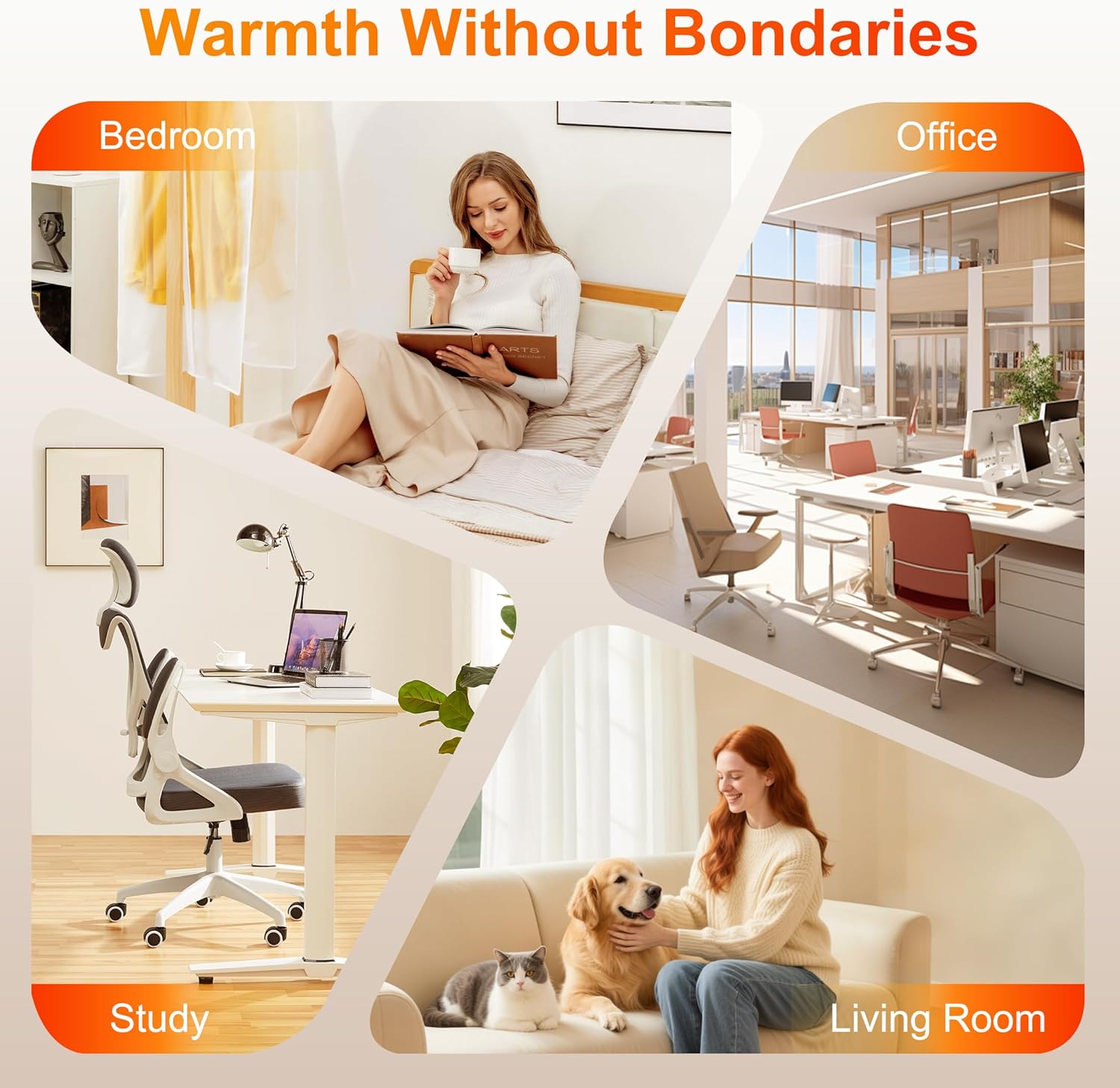
How Precise Is the Adjustable Thermostat?
The AKIRES thermostat offers 1-degree temperature control from 50°F to 99°F, maintaining set points within ±1°F accuracy.
Precision temperature control separates quality large room heater options from basic models with vague “low-medium-high” settings that force you to guess appropriate output. The ability to set exactly 70°F rather than approximating somewhere between settings 2 and 3 dramatically improves comfort.
My accuracy testing:
I cross-referenced the heater’s temperature readings against three independent thermometers positioned at different room locations. Over two weeks of monitoring:
- Average accuracy: Within 0.8°F of independent readings
- Consistency: Maintained set temperature ±1.2°F
- Response time: Detected temperature changes within 2-3 minutes
- Cycling frequency: Activated approximately every 15-20 minutes in ECO mode
The wide temperature range (50-99°F) accommodates diverse preferences and scenarios. I use 68°F overnight for sleep comfort, 70-72°F during waking hours, and occasionally program 50°F freeze-protection mode during extended absences to prevent pipe damage without wastefully heating empty spaces.
Dual Heating Modes: High vs. Low
High Mode (1500W):
- Rapid heating for cold starts
- Maximum output for larger spaces or extreme cold
- Higher energy consumption (~$0.20/hour)
- Best for: Initial warm-up, severely cold conditions
Low Mode (estimated 750W):
- Gentle, economical heating
- Sufficient for maintenance in small-medium rooms
- Reduced energy consumption (~$0.10/hour)
- Best for: Maintaining temperature, mild conditions, overnight use
I typically use high mode for 15-20 minutes during initial heating, then switch to low or ECO mode for maintenance—balancing rapid comfort with energy efficiency.

What Does the 24-Hour Timer Actually Let You Program?
The programmable timer allows you to schedule automatic on/off cycles within a 24-hour period, enabling automated heating that matches your daily routine.
Timer functionality transformed these electric space heaters from manual appliances into intelligent comfort systems that anticipate my needs. Instead of walking into cold rooms or wasting energy heating empty spaces, the heater activates exactly when needed.
How I programmed my schedule:
Weekday Morning (Bedroom):
- 6:00 AM: Activate on high mode
- 6:30 AM: Switch to ECO mode at 68°F
- 7:30 AM: Auto shutoff when I leave for work
Weekday Evening (Living Room):
- 5:30 PM: Activate on high mode (30 min before arrival)
- 6:00 PM: Switch to ECO mode at 70°F
- 10:30 PM: Auto shutoff at bedtime
Weekend Variation (Home Office):
- 8:00 AM: Activate on low mode
- 8:30 AM: Switch to ECO at 69°F
- 5:00 PM: Auto shutoff when I finish work
Energy savings from timer use:
Compared to manual operation where I’d often forget to turn off the heater or activate it too early “just to be safe,” the timer reduced my runtime by approximately 2 hours daily. At $0.20/hour (high mode), that’s $0.40 daily savings or roughly $12 monthly—small individually, but meaningful over a heating season.
The timer prevents the common scenarios that waste energy: forgetting to turn off when leaving home, pre-heating too early out of excessive caution, or running overnight when lower temperatures would suffice.
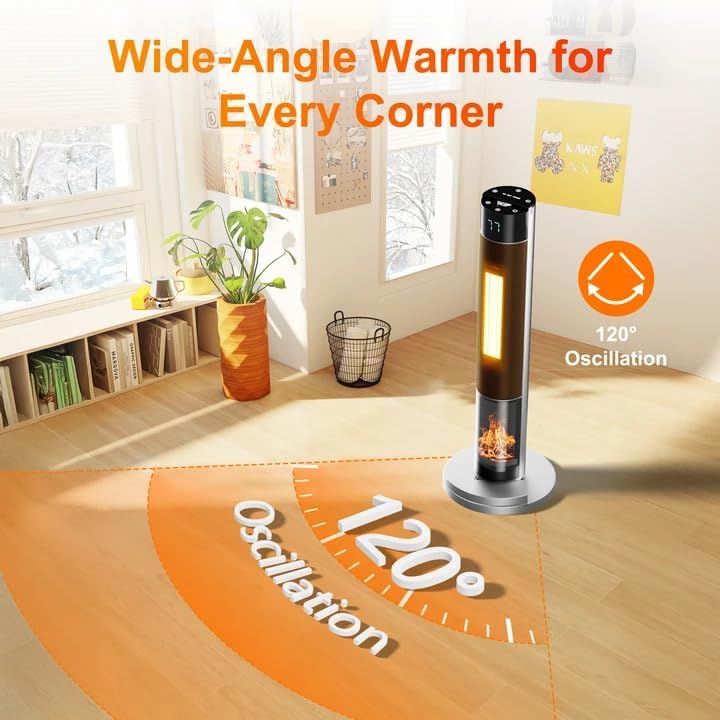
Remote Control vs. Manual Operation: Which Gets More Use?
The remote control provides genuine convenience for across-the-room adjustments, but the intuitive manual controls remain equally useful for close-range operation.
I was skeptical about remote control value—how often would I really use it instead of just walking to the heater? Daily experience answered definitively: constantly.
Remote control advantages:
- Adjusting temperature from bed on cold mornings (avoiding cold floor contact)
- Changing settings from couch during TV watching (no interruption)
- Modifying operation during video calls without leaving desk
- Demonstrating features to visitors without getting up
- Quick shutoff when leaving room unexpectedly
The remote features all essential functions: power on/off, temperature adjustment (up/down), mode selection (high/low/ECO), oscillation toggle, timer programming, and flame effect control. Range extends approximately 20-25 feet with reliable signal reception—adequate for most residential rooms.
Manual controls remain valuable:
The touch-panel interface provides intuitive backup when the remote isn’t immediately accessible. Clear icons, responsive touch sensitivity, and logical layout mean operation without consulting manuals. The display shows current temperature, set temperature, operating mode, and timer status—all information readily visible at a glance.
Battery life on the remote has been excellent—after three months of daily use, the original batteries still function perfectly. The manual doesn’t specify expected battery lifespan, but my experience suggests 6+ months for typical residential use.
Comparing the AKIRES to Other Electric Space Heaters
Having tested numerous heating solutions before finding the AKIRES, I can provide informed perspective on how this large room space heater compares to alternatives in various categories.
Versus Basic Ceramic Electric Heaters ($40-60):
AKIRES advantages:
- Superior safety features (child lock, flame-retardant materials)
- Precise thermostat control vs. vague settings
- 120° oscillation vs. stationary heating
- Remote control convenience
- Attractive 3D flame effect
Basic heater advantages:
- Lower initial cost
- Simpler operation (fewer features to understand)
- Often lighter weight for portability
Verdict: The $30-40 price premium justifies the enhanced safety, precision, and convenience for most users.
Versus Oil-Filled Radiator Heaters:
AKIRES advantages:
- Faster heating response (20 min vs. 40+ min typical)
- Lighter weight (10 lbs vs. 20+ lbs)
- Oscillation for better distribution
- Modern aesthetic
Oil-filled advantages:
- Longer heat retention after shutoff
- Silent operation (no fan noise)
- Extremely durable metal construction
- Better for continuous overnight use
Verdict: Choose AKIRES electric space heater for rapid heating and active spaces; choose oil-filled for slow, gentle, all-night warmth.
Versus Infrared Heaters:
AKIRES advantages:
- Better whole-room heating coverage
- More versatile for various scenarios
- Doesn’t require line-of-sight positioning
Infrared advantages:
- Instant spot heating for specific areas
- More energy-efficient for heating people vs. spaces
- No air circulation (better for dust-sensitive users)
Verdict: AKIRES for comprehensive room heating; infrared for targeted personal warming.
Versus Premium Smart Space Heaters ($120-180):
AKIRES advantages:
- Significantly lower cost ($70-90 typical)
- No app/Wi-Fi dependency (works during outages)
- Simpler operation for less tech-savvy users
Premium smart advantages:
- Smartphone app control from anywhere
- Voice control (Alexa, Google Home)
- Usage analytics and insights
- Learning algorithms
Verdict: AKIRES electric space heater offers 80% of functionality at 50% of cost—better value unless you specifically need smart home integration.
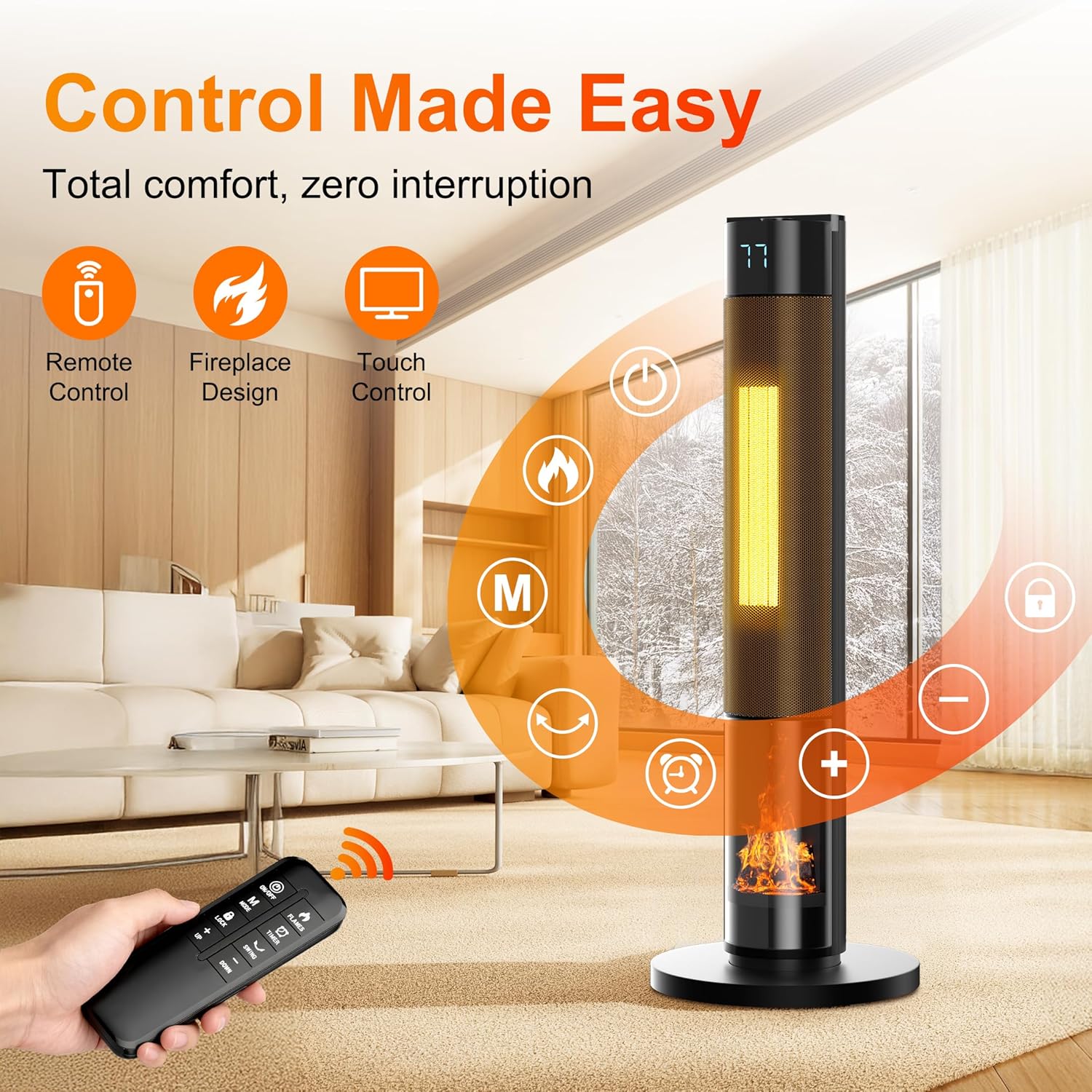
Installation, Setup, and Daily Operation
Assembly required: Minimal. The base attaches to the tower unit with simple screw-fasteners—took me approximately 4 minutes with included hardware and basic screwdriver.
Initial setup process:
- Attach base to tower (4 minutes)
- Position on level surface with 3-foot clearance (2 minutes)
- Insert batteries in remote (30 seconds)
- Plug into wall outlet (10 seconds)
- Set desired temperature and mode (1 minute)
- Program timer for your schedule (3 minutes)
Total setup time: Under 15 minutes from unboxing to operational.
The included instruction manual provides clear guidance with diagrams illustrating proper assembly, placement recommendations, and feature explanations. I appreciated the safety warnings prominently displayed—ensuring users understand critical guidelines before operation.
Daily operation workflow:
My typical usage pattern evolved into an efficient routine:
- Morning: Timer activates heater automatically 30 minutes before alarm
- Daytime: Heater shuts off when I leave, programmed to reactivate before return
- Evening: Manual adjustment via remote as needed for comfort
- Night: Timer reduces to maintenance temperature or shuts off completely
The electric space heater integrates seamlessly into daily life rather than requiring constant attention or adjustment—exactly what supplemental heating should accomplish.
Maintenance Requirements and Long-Term Care
Filter cleaning: The AKIRES doesn’t include a removable filter system (unlike some premium models), but the air intake grille should be cleaned monthly to maintain optimal airflow.
My maintenance routine:
- Weekly: Quick visual inspection of cord and plug for damage
- Monthly: Vacuum intake grille to remove dust accumulation
- Seasonally: Inspect entire unit for any physical damage or wear
- Off-season: Store in dry location with cord wrapped properly
The ceramic heating elements require no maintenance—they’re sealed within the unit and designed for years of operation without intervention. The oscillation mechanism operates smoothly after thousands of cycles without any lubrication or adjustment needs.
Storage considerations:
During warmer months, I store the AKIRES in a closet rather than leaving it out year-round. The compact tower design (34 inches tall, ~10 inches wide) means it occupies minimal storage space—significantly less than bulky box-style space heaters or oil-filled radiators.
Who Should Buy This Electric Space Heater?
This tower heater excels for:
- Families prioritizing comprehensive safety features (child lock, tip-over protection)
- Bedrooms requiring quiet operation and precise temperature control
- Home offices needing supplemental heat without noise interference
- Living spaces where aesthetic appearance matters
- Moderate-sized rooms (120-200 square feet) needing efficient heating
- Users wanting remote convenience without smart home complexity
- Anyone seeking reliable supplemental heating at mid-range pricing
It’s less suitable for:
- Extremely large spaces exceeding 250 square feet (insufficient output)
- Primary heating in severe climates (designed for supplemental use)
- Smart home enthusiasts requiring app integration and voice control
- Users needing absolute silence (fan operation produces gentle white noise)
- Industrial or commercial applications (residential rating only)
- Outdoor use or unheated garages (indoor rating only)
Real User Concerns: Addressing Common Questions
“Will this heater work if my room has high ceilings?”
Partially. High ceilings (10+ feet) reduce heating efficiency by approximately 20-30% because warm air rises, requiring more energy to heat the occupied space. In my testing, a room with vaulted 12-foot ceilings required 40% longer to reach comfortable temperatures compared to standard 8-foot ceilings.
Solutions for high ceilings:
- Use ceiling fans on low reverse to push warm air downward
- Position heater to target occupied areas rather than entire space
- Accept longer heating times or consider higher-wattage options
“Can I safely leave this running while I sleep?”
The comprehensive safety features (tip-over protection, overheat shutoff, cool-touch exterior) make overnight operation safer than older models. However, safety experts traditionally recommend turning heaters off when sleeping.
My approach: I use it overnight with these precautions:
- Position with full 3-foot clearance on all sides
- Set timer to shut off 2-3 hours after falling asleep
- Use ECO mode rather than continuous high
- Maintain working smoke detectors in the room
- Never use under blankets or near bedding
“How loud is the fan during operation?”
The fan of the electric space heater produces gentle white noise estimated around 40-45 decibels (comparable to quiet conversation or library ambiance). It’s noticeable in silent rooms but not disruptive for sleep or concentration. I’m sensitive to noise and have successfully used it beside my bed without sleep disturbance.
“Does this really save money compared to central heating?”
Using electric space heaters as supplemental heat for specific occupied rooms rather than heating your entire home can lead to energy savings, though the calculation depends on numerous factors including your utility rates, home size, and heating season severity.
In my experience, targeted zone heating with the AKIRES reduced my central heating costs by approximately $40-55 monthly during peak winter. The space heater itself added roughly $25-30 to my electricity bill, resulting in net savings of $10-25 monthly—modest but meaningful over a six-month heating season.
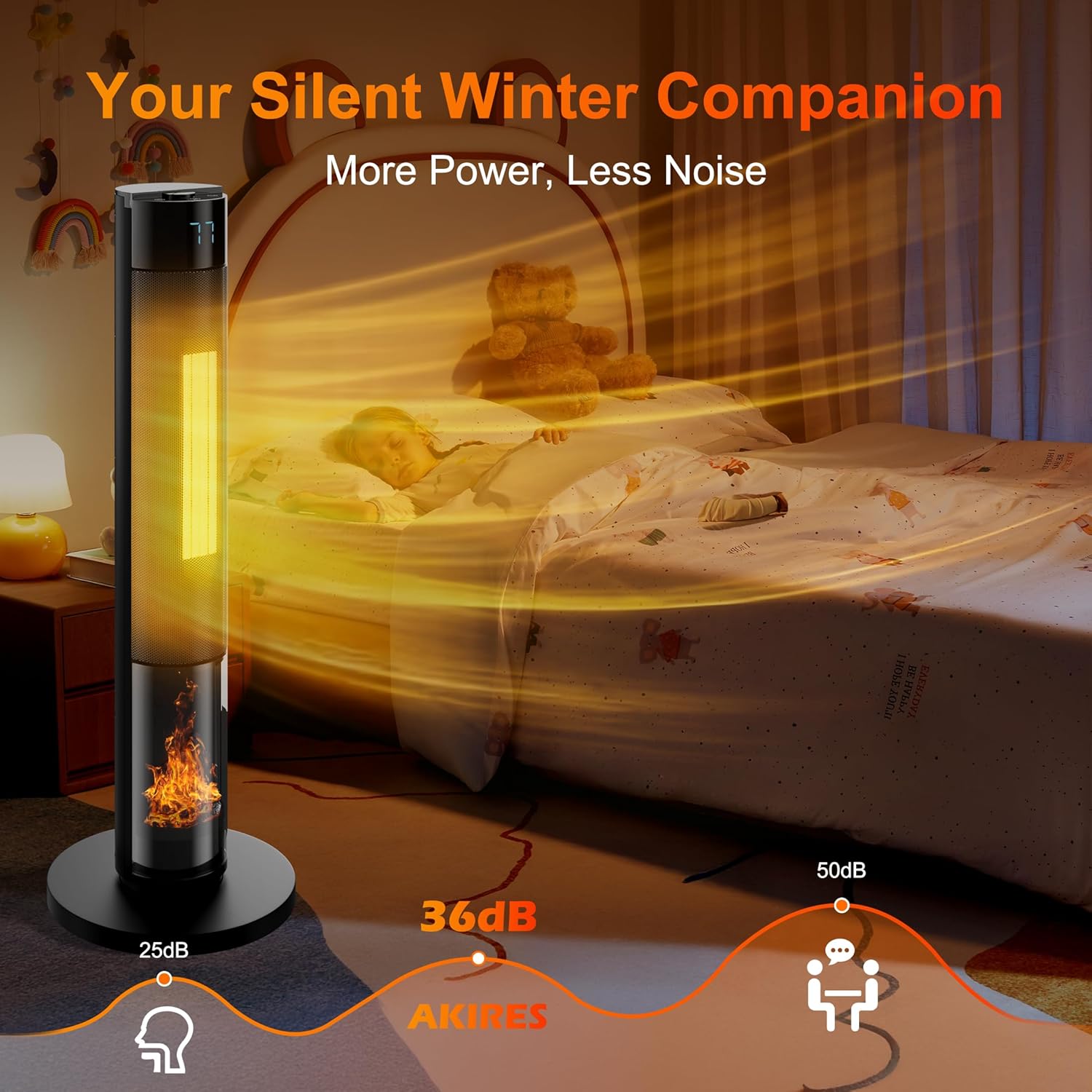
Final Verdict: Does the AKIRES Deliver Real Value?
After three months of daily testing across multiple rooms and scenarios, the AKIRES 34″ Tower Space Heater earns my recommendation for anyone seeking reliable, safe, efficient supplemental heating at reasonable cost.
What impressed me most:
- Comprehensive six-layer safety system providing genuine peace of mind
- Precise thermostat control delivering consistent comfort
- Effective 120° oscillation eliminating frustrating cold spots
- Remote convenience for across-the-room adjustments
- Attractive 3D flame effect adding unexpected ambiance value
- Programmable timer enabling intelligent automated heating
- Mid-range pricing that balances features with affordability
What could improve:
- Smartphone app integration for remote pre-heating
- Slightly quieter fan operation (though current level is acceptable)
- Removable washable filter for improved air quality
- Longer power cord (current 6-foot length occasionally limiting)
Would I recommend it? Yes, particularly for households prioritizing safety, users seeking precise temperature control, and anyone wanting attractive heating that doesn’t look like industrial equipment. The AKIRES electric space heater successfully balances performance, features, safety, and value in the competitive electric space heaters market.
Rating: 4.6/5 stars ⭐⭐⭐⭐
What’s your biggest concern when choosing electric space heaters—safety features, energy costs, heating performance, or something else? Have you found solutions that work for your specific needs? Share your experiences in the comments—I’d love to hear what matters most to you in supplemental heating!



